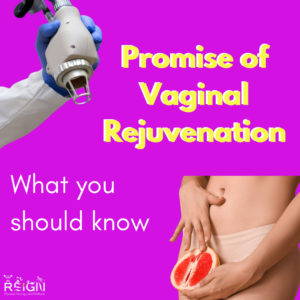
Have you heard about feminine rejuvenation? Or, maybe Mona Lisa? What about Femilift?
All of these procedures refer to the use of fractional carbon dioxide lasers being used for treatment of vulvar and vaginal issues. Often times, you hear it being referred to a “rejuvenation” of these tissues. This procedure is often marketed towards cancer survivors and perimenopausal/menopausal women.
In recent years, fractional carbon dioxide (CO2) lasers have been marketed as revolutionary treatments for a variety of vulva and vaginal issues, including dryness, looseness, incontinence, and pain. While these procedures are often advertised as minimally invasive with quick recovery times, there are important concerns that anyone considering this treatment should be aware of. Let’s break down the key issues surrounding fractional CO2 laser therapy for vulva and vaginal health.
Lack of FDA Approval for Vaginal Rejuvenation
The U.S. Food and Drug Administration (FDA) has not approved fractional CO2 lasers for the treatment of vaginal or vulvar conditions. In fact, the FDA has issued warnings to manufacturers about marketing these devices for unapproved uses, emphasizing the lack of evidence supporting their safety and efficacy for such conditions. When a device is used in ways not approved by the FDA, it becomes an “off-label” application, which can carry additional risks due to limited clinical testing in that specific area.
ACOG’s Position on Laser Treatments
The American College of Obstetricians and Gynecologists (ACOG) has taken a cautious stance on the use of laser treatments for vaginal rejuvenation and related issues. ACOG highlights the lack of high-quality research demonstrating the safety and effectiveness of these procedures. In their view, more robust, long-term studies are needed to evaluate both the potential benefits and risks. This skepticism from leading experts in women’s health underscores the need for patients to exercise caution.
What Does The Research Say?
Not much at all. Currently, we do not have a lot of information on this treatment for vulvar and vaginal issues. It is rather alarming that with the lack of research for this treatment that continues to gain traction in medical spas and various practice types. With the current research that is available, it indicates that fractional CO2 lasers was not more effective than sham treatment for vulvar and vaginal issues. Sham treatment simply means an inactive treatment or placebo. If this is the case, the sham treatment would offer less associated risks and still provide a similar outcome.
Risks of Tissue Damage
One of the most significant concerns with fractional CO2 laser treatments is the risk of tissue damage. The procedure works by creating controlled micro-injuries in the tissue to stimulate collagen production. However, the vaginal and vulvar tissues are highly sensitive, and improper application of the laser can result in:
Burns and scarring: Over-treatment or excessive energy levels can cause burns or permanent scarring, leading to pain and dysfunction.
Chronic pain: Some individuals report long-term discomfort or hypersensitivity after laser treatments.
Increased risk of infection: Micro-injuries create openings in the tissue that can serve as entry points for bacteria, increasing the risk of infection.
Limited Evidence of Long-Term Benefits
While some women report temporary improvement in symptoms like dryness or discomfort, there is limited evidence to suggest long-term benefits from fractional CO2 laser treatments. In some cases, symptoms may return after several months, necessitating repeat procedures. This raises questions about the cost-effectiveness and practicality of this treatment over time.
What Can You Do Instead
If you are experiencing vulva or vaginal issues, there are safer, more evidence-based options available:
Pelvic floor physical therapy: This approach can address many causes of discomfort, laxity, and pain through targeted exercises and techniques.
Hormonal treatments: For those dealing with menopausal symptoms like dryness, low-dose vaginal estrogen or other hormonal therapies may provide relief.
Lubricants and moisturizers: Over-the-counter products can help manage dryness and discomfort.
Here are some lubrication suggestions: UberLube SlipperyStuff
Here are some moisturizer suggestions: Kindra Daily V Lotion Kinda V Serum Medicine Mama Vulva Balm
Vibration therapy: This can be a non-invasive way to support tissue health and improve symptoms. Vibration has been shown to improve blood flow, reduce muscle tension, and address complaint of pain.
Here are some product suggestions: Intimate Rose Vibrating Pelvic Wand VWell Vibrating Flexible Wand
Consult a specialist: Always consult with a medical provider (gynecologist, urogynecologist, and/or a pelvic floor therapist) to discuss your symptoms and explore treatment options tailored to your needs.
The Bottom Line
Fractional CO2 laser treatments may seem like a promising solution for vulva and vaginal issues, but the lack of FDA approval, limited support from ACOG, and risks of tissue damage make it a less-than-ideal choice for most individuals. Before considering any procedure, it’s essential to consult with a qualified healthcare provider and explore safer, evidence-based alternatives. Your health and well-being deserve nothing less.
